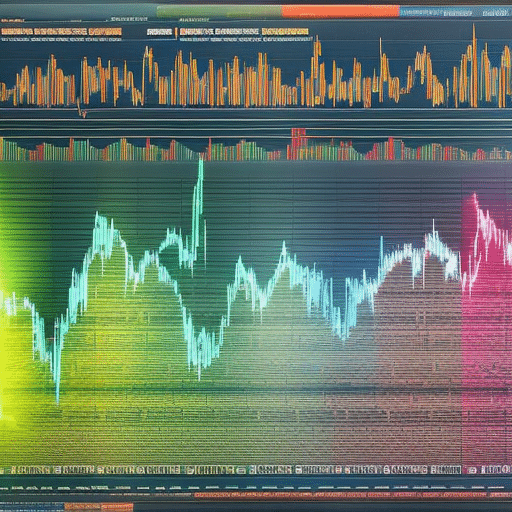In the rapidly evolving world of cryptocurrency trading, the ability to accurately forecast market trends and make informed decisions is essential. This is where cryptocurrency technical indicators prove their worth. These mathematical calculations, based on historical price movement and other data, provide traders with valuable insights into market behavior. By understanding and effectively utilizing these indicators, traders can gain a comprehensive view of the market and increase their chances of success in this dynamic industry.
Table of Contents
ToggleUnderstanding Cryptocurrency Technical Indicators
One essential aspect of analyzing cryptocurrency markets is understanding the various technical indicators available. Technical indicators are mathematical calculations based on historical price movement, volume, or open interest data. Their purpose is to forecast future market behavior. There are different types of trading indicators, each with its own strengths and weaknesses. They can be categorized as trend-following or momentum indicators. Trend-following indicators recognize and track the direction of a trend in the cryptocurrency market. Moving Average (MA) is an example of a trend-following indicator. MAs smooth out price data to create a trend line based on historical prices. Momentum indicators, on the other hand, gauge the rate of price changes over specific time periods. Relative Strength Index (RSI) is a frequently used momentum indicator. RSI oscillates between 0 and 100 and identifies overbought and oversold conditions, indicating a likely continuation of the trend. It is important for traders to experiment and find the indicator combination that works best for their trading style, continuously refining their usage based on market conditions and personal experience.
Trend-Following Indicators
Trend-following indicators accurately track the direction of trends in the cryptocurrency market. These indicators are useful for traders who want to identify and ride the trend for maximum profit potential. Here are three key points about trend-following indicators:
- Moving Average (MA) is a popular trend-following indicator that smooths out price data to create a trend line based on historical prices. It helps traders identify the current direction of the trend.
- Trend-following indicators do not predict price direction, but rather define the current trend direction. They are useful for confirming the presence of a trend and determining when it might be weakening or reversing.
- By using trend-following indicators, traders can align their strategies with the prevailing market trend, increasing their chances of making profitable trades.
Understanding and utilizing trend-following indicators can provide traders with valuable insights into market trends and help them make informed trading decisions.
Moving Average (MA)
Moving Average (MA) is a widely used trend-following indicator in the cryptocurrency market that smooths out price data to create a trend line based on historical prices. It is a lagging indicator that helps traders identify the current direction of a trend. MA calculates the average price over a specified period, such as 50 days or 200 days, and plots it on a chart. Traders use different types of MA, such as simple moving average (SMA) or exponential moving average (EMA), depending on their preference and trading strategy. MA can act as support or resistance levels, signal potential trend reversals, and provide insights into market strength. By analyzing the MA crossover, where short-term MA crosses above or below long-term MA, traders can identify potential buy or sell signals. However, it’s important to note that MA is not a predictive indicator and should be used in conjunction with other technical analysis tools for more accurate readings.
Momentum Indicators
Momentum indicators play a crucial role in analyzing the rate of price changes and identifying overbought and oversold conditions in the cryptocurrency market. These indicators provide valuable insights into the strength and speed of price movements, helping traders make informed decisions. Here are three key points about momentum indicators:
-
Relative Strength Index (RSI): One of the most commonly used momentum indicators, RSI oscillates between 0 and 100 and helps identify overbought and oversold conditions. A reading above 70 suggests overbought conditions, while a reading below 30 indicates oversold conditions.
-
Moving Average Convergence Divergence (MACD): This indicator measures market momentum and is particularly helpful in predicting future trends and timing entry and exit points. It consists of two lines – the MACD line and the signal line – and the crossing of these lines provides trading signals.
-
Stochastic Oscillator: The stochastic oscillator measures the speed of price movement and identifies overbought and oversold conditions. It oscillates between 0 and 100 and is used to determine potential trend reversals.
Relative Strength Index (RSI)
The Relative Strength Index (RSI) is a widely used momentum indicator that provides valuable insights into market dynamics and helps traders make informed decisions about overbought and oversold conditions. The RSI oscillates between 0 and 100 and is calculated based on the average gains and losses over a specified period. When the RSI is above 70, it suggests that the market is overbought and a price correction may be imminent. Conversely, when the RSI is below 30, it indicates that the market is oversold and a potential price reversal may occur. Traders can use the RSI to identify potential entry and exit points, as well as to confirm the strength of a trend. By understanding the RSI, traders can gain a better understanding of market sentiment and improve their trading strategies.
Specific Indicators and Their Functions
One commonly used indicator in cryptocurrency trading is the Moving Average (MA). MAs are trend-following indicators that smooth out price data to create a trend line based on historical prices. They are used to identify trends, potential reversals, and act as support and resistance levels. Another popular indicator is the Moving Average Convergence / Divergence (MACD), which measures market momentum and helps predict future trends and time entries and exits. Bollinger Bands are also widely used and are used to predict price movements and identify trend continuations or reversals. These indicators, along with others such as the Stochastic Oscillator, Average Directional Index (ADX), Parabolic Stop and Reverse (SAR), On-Balance Volume (OBV), and Ichimoku Cloud (IC), each have their own specific functions and can provide valuable insights for cryptocurrency traders.
Moving Average Convergence / Divergence (MACD)
Moving Average Convergence / Divergence (MACD) is another widely used indicator in cryptocurrency trading that builds upon the previous subtopic’s discussion of specific indicators. MACD measures market momentum and helps predict future trends and time entries and exits. It consists of two lines: the MACD line and the signal line. The MACD line is calculated by subtracting the longer-term moving average from the shorter-term moving average. The signal line is a moving average of the MACD line. When the MACD line crosses above the signal line, it is considered a bullish signal, indicating a potential buying opportunity. Conversely, when the MACD line crosses below the signal line, it is considered a bearish signal, indicating a potential selling opportunity. Traders often use MACD in combination with other indicators to confirm signals and improve their trading decisions.
Bollinger Bands
Bollinger Bands are commonly used technical indicators in cryptocurrency trading, frequently employed to predict price movements and identify potential trend continuations or reversals. These indicators consist of a simple moving average (SMA) in the middle, with an upper band and a lower band that are calculated based on standard deviations from the SMA. Here are three key points about Bollinger Bands:
-
Volatility Measurement: Bollinger Bands expand and contract based on market volatility. When the bands widen, it indicates higher volatility, while narrowing bands indicate lower volatility.
-
Support and Resistance Levels: The upper and lower bands act as dynamic support and resistance levels. Prices tend to bounce off the bands, indicating potential reversal points.
-
Squeeze Patterns: Bollinger Bands can also help identify squeeze patterns, where the bands contract tightly. This suggests a period of low volatility and is often followed by a significant price breakout.
Stochastic Oscillator
The Stochastic Oscillator is a widely used technical indicator that measures the speed of price movement and identifies overbought and oversold conditions in the cryptocurrency market. It consists of two lines – %K and %D – that fluctuate between 0 and 100. The %K line represents the current closing price relative to the recent price range, while the %D line is a moving average of the %K line. Traders often look for the %K line crossing above or below the %D line to generate buy or sell signals, respectively. When the indicator is in the overbought zone (above 80), it suggests that the cryptocurrency is due for a potential reversal or correction. Conversely, when it is in the oversold zone (below 20), it indicates a possible buying opportunity. By incorporating the Stochastic Oscillator into their analysis, traders can gain insights into market conditions and make informed trading decisions.
| Indicator Name | Calculation Method | Interpretation |
|---|---|---|
| %K Line | (Current Close – Lowest Low) / (Highest High – Lowest Low) * 100 | Represents the current closing price relative to the recent price range. |
| %D Line | Simple Moving Average of %K Line | Represents a moving average of the %K line. |
| Overbought Zone | Above 80 | Suggests that the cryptocurrency is due for a potential reversal or correction. |
| Oversold Zone | Below 20 | Indicates a possible buying opportunity. |
Average Directional Index (ADX)
The Average Directional Index (ADX) is another commonly used technical indicator that measures market trend strength, building on the previous discussion of the Stochastic Oscillator. It was developed by J. Welles Wilder and aims to determine the strength of a trend rather than its direction. The ADX calculates the average of positive and negative directional movement indicators (DMI) over a specified period. Here are key points about the ADX:
- ADX values range from 0 to 100. Higher values indicate a stronger trend, while lower values suggest a weak or indecisive market.
- Traders often use the ADX to confirm the presence of a trend before making trading decisions.
- The ADX can also help identify potential trend reversals when the trend strength starts to weaken.
Parabolic Stop and Reverse (SAR)
Continuing the discussion on technical indicators in cryptocurrency trading, let’s now delve into the Parabolic Stop and Reverse (SAR) indicator. SAR is a trend-following indicator that can identify potential reversals in the market. It is often used as a trailing stop loss to protect profits and limit losses. The SAR indicator plots dots above or below the price chart, indicating the direction of the trend. When the price is above the dots, the trend is bullish, and when the price is below the dots, the trend is bearish. As the price continues to move in one direction, the dots will adjust accordingly, creating a trailing stop. Traders can use this indicator to set their stop loss levels and exit positions when the trend reverses. SAR is a valuable tool for identifying trend reversals and managing risk in cryptocurrency trading.
On-Balance Volume (OBV)
Moving on to the next indicator in the discussion of technical indicators in cryptocurrency trading, let us now explore the concept of On-Balance Volume (OBV). OBV is a momentum indicator that measures buying and selling pressure by adding or subtracting the volume traded during up and down price movements. Here are three key points to understand about OBV:
- OBV can confirm price movements: When the OBV line moves in the same direction as the price, it confirms the trend. If the OBV line diverges from the price, it may signal a potential reversal.
- OBV can identify accumulation and distribution: If the OBV line is rising while the price is relatively stable, it suggests accumulation. Conversely, if the OBV line is falling while the price remains steady, it indicates distribution.
- OBV can be used for divergence analysis: Divergence between the OBV line and the price can signal a trend reversal. Bullish divergence occurs when the price makes a lower low while the OBV line makes a higher low, indicating buying pressure. Bearish divergence occurs when the price makes a higher high while the OBV line makes a lower high, indicating selling pressure.
Ichimoku Cloud (IC)
One popular and effective indicator used in cryptocurrency trading is the Ichimoku Cloud (IC). The Ichimoku Cloud is a comprehensive indicator that provides valuable information about support and resistance levels, trend direction, and potential trend reversals. It consists of five lines: Tenkan-sen (Conversion Line), Kijun-sen (Base Line), Senkou Span A (Leading Span A), Senkou Span B (Leading Span B), and Chikou Span (Lagging Span). These lines form a cloud-like structure on the chart, which helps traders identify key levels and trends. The Ichimoku Cloud is particularly useful for determining trend strength and direction, as well as potential entry and exit points. By analyzing the interactions between the different lines, traders can gain valuable insights into market dynamics and make more informed trading decisions.
| Line | Name | Function |
|---|---|---|
| 1 | Tenkan-sen | Measures short-term momentum and signal potential trend reversals |
| 2 | Kijun-sen | Provides a longer-term perspective on the market’s strength and direction |
| 3 | Senkou Span A | Represents the midpoint between the Tenkan-sen and Kijun-sen, acts as a leading indicator |
| 4 | Senkou Span B | Measures long-term support and resistance levels, defines the cloud’s boundaries |
| 5 | Chikou Span | Reflects current closing price, helps confirm trend signals and identify potential reversals |
Effective Use of Indicators in Trading
To maximize trading success and gain valuable insights into market dynamics, it is crucial for traders to effectively utilize cryptocurrency indicators. Here are three key points to consider:
-
Combining indicators: By combining different indicators, traders can obtain a more comprehensive analysis of market trends. Experimenting with indicator combinations and finding what works best for their trading style is essential.
-
Continuous refinement: Professional traders often use indicators as part of their trading strategy and continuously refine their usage based on market conditions and personal experience. This ongoing refinement helps adapt to changing market dynamics and improve trading decisions.
-
Exit indicators: The Relative Strength Index (RSI) and Moving Average Indicator are considered some of the best exit indicators. However, traders should consider using a combination of indicators for more reliable exit signals, as even the best indicators can be inaccurate.
Recommended Settings for RSI and Stochastic Indicators
The optimal configuration for RSI and Stochastic indicators in cryptocurrency trading can greatly impact their effectiveness and reliability. The Relative Strength Index (RSI) and Stochastic Oscillator are both momentum indicators that help identify overbought and oversold conditions in the market. When it comes to setting up these indicators, there are no fixed rules as the optimal settings may vary depending on the specific cryptocurrency being traded and the time frame being analyzed. Traders often experiment with different settings and adjust them based on their trading style and market conditions. It is recommended to start with the default settings of 14 periods for RSI and 14,3,3 for the Stochastic Oscillator and then fine-tune them according to personal preferences and trading experience. Regularly reviewing and adjusting the settings is crucial for maximizing the effectiveness of these indicators in cryptocurrency trading.
Frequently Asked Questions
How Do Technical Indicators Differ From Fundamental Analysis in Cryptocurrency Trading?
Technical indicators in cryptocurrency trading differ from fundamental analysis by focusing on historical price data and mathematical calculations. They aim to forecast market behavior based on trends and momentum, while fundamental analysis considers underlying factors like company financials and economic conditions.
Can Technical Indicators Accurately Predict Future Market Behavior in the Cryptocurrency Market?
Technical indicators in the cryptocurrency market aim to forecast future behavior by analyzing historical price movement, volume, and open interest data. While no indicator can perfectly predict market behavior, combining multiple indicators can provide a more comprehensive analysis.
Is It Necessary to Use Multiple Indicators in Trading, or Can One Indicator Be Sufficient?
Using multiple indicators is recommended in trading as it provides a more comprehensive analysis of market trends. One indicator alone may not be sufficient, as different indicators offer unique insights into market conditions, enhancing the accuracy of trading decisions.
What Are Some Common Mistakes That Traders Make When Using Technical Indicators?
Some common mistakes traders make when using technical indicators include relying solely on one indicator, not considering market conditions, ignoring price action, and overcomplicating their strategy with too many indicators.
Are There Any Specific Indicators That Are More Effective for Short-Term Trading Versus Long-Term Trading in the Cryptocurrency Market?
There are specific indicators that are more effective for short-term trading versus long-term trading in the cryptocurrency market. These indicators include Moving Average Convergence/Divergence (MACD), Bollinger Bands, and Stochastic Oscillator, among others.





















